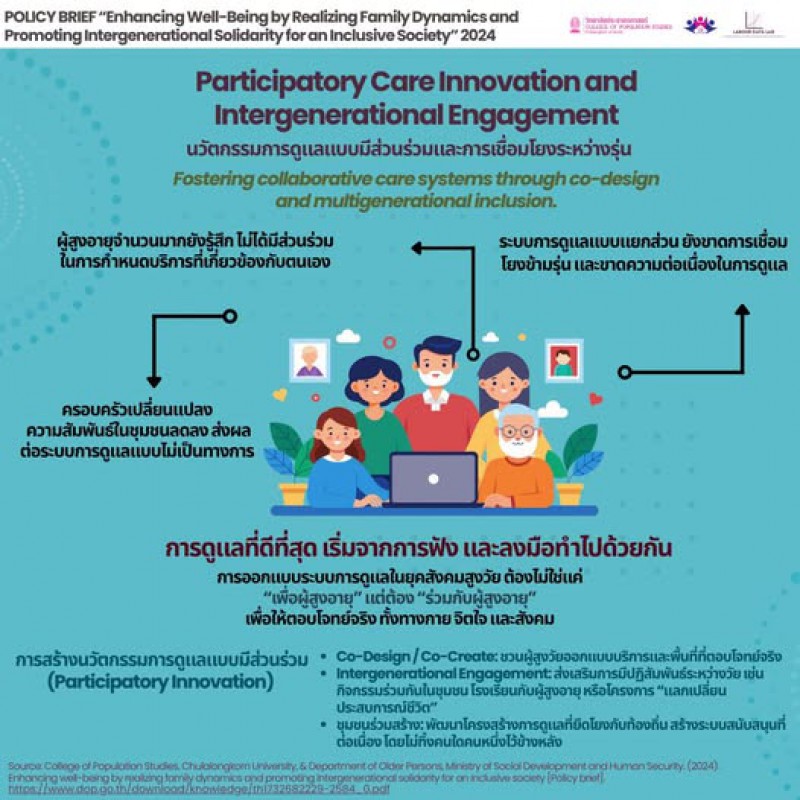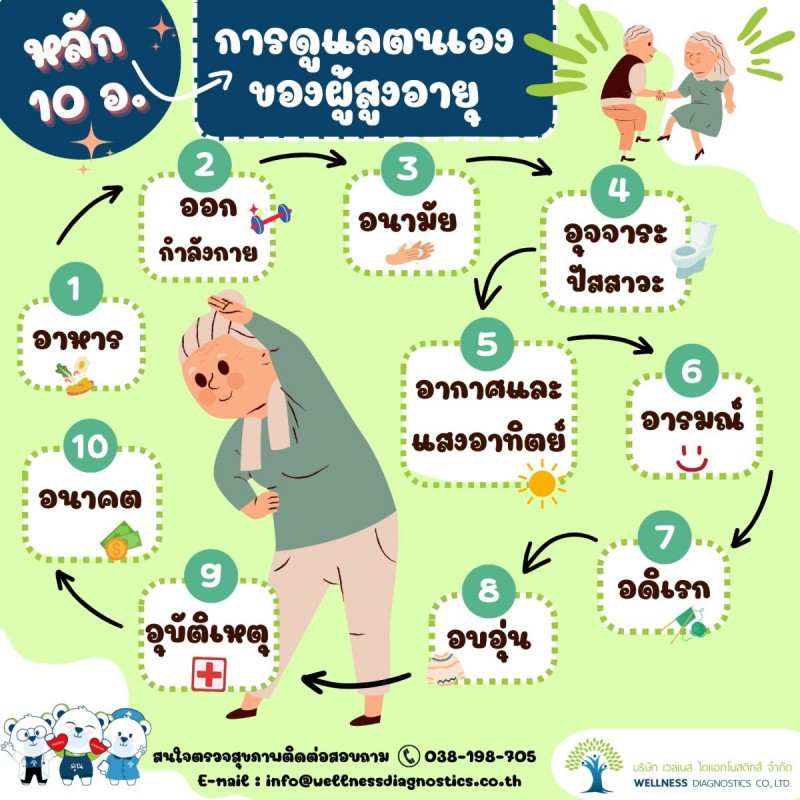นวัตกรรมการดูแลแบบมีส่วนร่วมและการเชื่อมโยงระหว่างรุ่น

วันที่ 16 ก.ค. 2568 |
ผู้เข้าชม 28 ครั้ง
นวัตกรรมการดูแลแบบมีส่วนร่วมและการเชื่อมโยงระหว่างรุ่น
การออกแบบระบบการดูแลในยุคสังคมสูงวัย ต้องไม่ใช่แค่ “เพื่อผู้สูงอายุ” แต่ต้อง “ร่วมกับผู้สูงอายุ” เพื่อให้ตอบโจทย์จริง ทั้งทางกาย จิตใจ และสังคม
จาก POLICY BRIEF ปี 2024 ชี้ให้เห็นว่า
 ผู้สูงอายุจำนวนมากยังรู้สึก ไม่ได้มีส่วนร่วม ในการกำหนดบริการที่เกี่ยวข้องกับตนเอง
ผู้สูงอายุจำนวนมากยังรู้สึก ไม่ได้มีส่วนร่วม ในการกำหนดบริการที่เกี่ยวข้องกับตนเอง
 ระบบการดูแลแบบแยกส่วน ยังขาดการเชื่อมโยงข้ามรุ่น และขาดความต่อเนื่องในการดูแล
ระบบการดูแลแบบแยกส่วน ยังขาดการเชื่อมโยงข้ามรุ่น และขาดความต่อเนื่องในการดูแล
 ครอบครัวเปลี่ยนแปลง ความสัมพันธ์ในชุมชนลดลง ส่งผลต่อระบบการดูแลแบบไม่เป็นทางการ
ครอบครัวเปลี่ยนแปลง ความสัมพันธ์ในชุมชนลดลง ส่งผลต่อระบบการดูแลแบบไม่เป็นทางการ
ดังนั้น แนวทางใหม่จึงเน้น การสร้างนวัตกรรมการดูแลแบบมีส่วนร่วม (Participatory Innovation) เช่น:
 Co-Design / Co-Create: ชวนผู้สูงวัยออกแบบบริการและพื้นที่ที่ตอบโจทย์จริง
Co-Design / Co-Create: ชวนผู้สูงวัยออกแบบบริการและพื้นที่ที่ตอบโจทย์จริง
 Intergenerational Engagement: ส่งเสริมการมีปฏิสัมพันธ์ระหว่างวัย เช่น กิจกรรมร่วมกันในชุมชน โรงเรียนกับผู้สูงอายุ หรือโครงการ “แลกเปลี่ยนประสบการณ์ชีวิต”
Intergenerational Engagement: ส่งเสริมการมีปฏิสัมพันธ์ระหว่างวัย เช่น กิจกรรมร่วมกันในชุมชน โรงเรียนกับผู้สูงอายุ หรือโครงการ “แลกเปลี่ยนประสบการณ์ชีวิต”
 ชุมชนร่วมสร้าง: พัฒนาโครงสร้างการดูแลที่ยึดโยงกับท้องถิ่น สร้างระบบสนับสนุนที่ต่อเนื่อง โดยไม่ทิ้งคนใดคนหนึ่งไว้ข้างหลัง
ชุมชนร่วมสร้าง: พัฒนาโครงสร้างการดูแลที่ยึดโยงกับท้องถิ่น สร้างระบบสนับสนุนที่ต่อเนื่อง โดยไม่ทิ้งคนใดคนหนึ่งไว้ข้างหลัง
 Participatory Care Innovation and Intergenerational Engagement
Participatory Care Innovation and Intergenerational Engagement
In an ageing society, care systems must go beyond being “for older persons” — they must be “co-created with older persons.” Effective care addresses not just physical and mental needs, but also emotional and social well-being.
According to the 2024 Policy Brief, key challenges include:
 Many older persons feel excluded from decisions about services that affect their lives.
Many older persons feel excluded from decisions about services that affect their lives.
 Existing care systems are often fragmented, lacking intergenerational connection and continuity.
Existing care systems are often fragmented, lacking intergenerational connection and continuity.
 Changes in family structures and weakened community ties have disrupted informal caregiving networks.
Changes in family structures and weakened community ties have disrupted informal caregiving networks.
To address these gaps, a new approach emphasizes participatory care innovation, including:
 Co-Design / Co-Create
Co-Design / Co-Create
Engaging older persons in the design of services and spaces that genuinely meet their needs.
 Intergenerational Engagement
Intergenerational Engagement
Encouraging interaction across generations through joint activities — such as community programs, school-elder collaborations, and “life experience exchange” projects.
 Community Co-Creation
Community Co-Creation
Strengthening local care ecosystems by involving communities and local governments in building inclusive, sustainable, and people-centered support systems — ensuring no one is left behind.
การออกแบบระบบการดูแลในยุคสังคมสูงวัย ต้องไม่ใช่แค่ “เพื่อผู้สูงอายุ” แต่ต้อง “ร่วมกับผู้สูงอายุ” เพื่อให้ตอบโจทย์จริง ทั้งทางกาย จิตใจ และสังคม
จาก POLICY BRIEF ปี 2024 ชี้ให้เห็นว่า
ดังนั้น แนวทางใหม่จึงเน้น การสร้างนวัตกรรมการดูแลแบบมีส่วนร่วม (Participatory Innovation) เช่น:
In an ageing society, care systems must go beyond being “for older persons” — they must be “co-created with older persons.” Effective care addresses not just physical and mental needs, but also emotional and social well-being.
According to the 2024 Policy Brief, key challenges include:
To address these gaps, a new approach emphasizes participatory care innovation, including:
Engaging older persons in the design of services and spaces that genuinely meet their needs.
Encouraging interaction across generations through joint activities — such as community programs, school-elder collaborations, and “life experience exchange” projects.
Strengthening local care ecosystems by involving communities and local governments in building inclusive, sustainable, and people-centered support systems — ensuring no one is left behind.
ข่าวที่เกี่ยวข้อง

6 สิ่งที่คนอายุยืนถึง 100 ปีทำเหมือนกัน
21 ต.ค. 2568

หลัก 10 อ. การดูแลตนเองของผู้สูงอายุ
21 ต.ค. 2568


